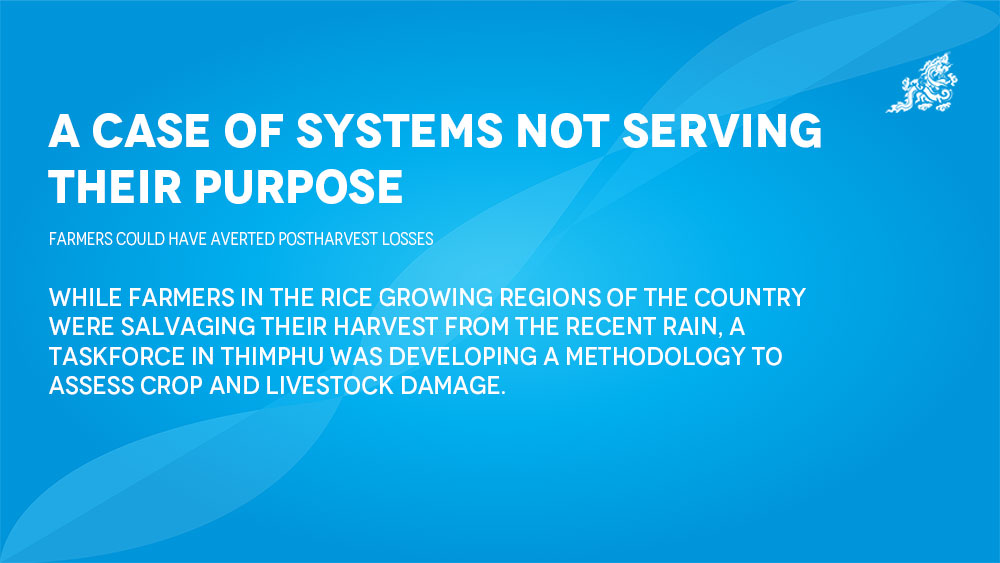Farmers could have averted postharvest losses
Tashi Dema
While farmers in the rice growing regions of the country were salvaging their harvest from the recent rain, a taskforce in Thimphu was developing a methodology to assess crop and livestock damage.
The methodology was being developed as a part of the Green Climate Fund (GCF) project’s intervention to calculate crop and livestock damage and losses due to climate change impacts, develop assessment tools and a standard operation procedure (SOP) for crop and livestock damage and losses, and to institute a reporting system. Officials from Department of Agriculture (DoA), Department of Disaster Management (DDM), National Centre for Hydrology and Meteorology (NCHM), livestock, dzongkhag and Ministry of Agriculture and Forests participated in the task force.
It was a cruel coincidence, or a case of too little, too late.
“It’s an ongoing process and we will soon finalise the methodology,” an official from the DoA said. The department updated their website about the taskforce meeting on October 18, the day when incessant rain was pounding paddy fields in Paro and the Punakha-Wangdue valley.
There are no exact figures to show the extent of the damage to rice production due to the recent rain. Officials said they have asked dzongkhag agriculture officials to assess the damage. “It might take some time,” a senior official said.
Another official said their officials in the field are re-verifying the damages. “We will have the figures by next week.”
The official said the damage will impact the overall rice production in the country, as many rice-producing dzongkhags reported damage.
The recent incident, however, raised questions about the role of the NCHM, DDM, and DoA, with many questioning or wondering why the weather information the NCHM issued did not reach the farmers on time.
The NCHM, on the afternoon of October 17, issued a weather advisory that stated there would be light to moderate rainfall in the country from October 18 to 20. There was no specific warning to farmers.
A former parliamentarian called it a communication blackout, and said a simple communication of weather forecasts from concerned agencies to farmers through local government officials could have avoided the disaster.
There are others who said weather forecasts should be made available for the upcoming week, as people already cut their paddy crops and left them to dry when the weather prediction was made.
It could be a case of becoming wiser after an event, but the call is for timely flow of information and a warning from those who have access to those who lack vital information, like farmers.
The post-harvest paddy loss also comes after the DoA launched an agromet decision support system (ADSS) in March this year to provide specific crop advisories to farmers based on weather forecasts.
During the launch, officials said ADSS would help farmers make informed decisions and avert postharvest losses if they are informed on the possibility of rainfall during paddy crop harvest.
It has been more than seven months since the agromet system was launched. But the system failed to serve its purpose.
A source said that since the Bhutanese farming system is predominantly rain-fed and highly sensitive to climate variability and extreme weather events triggered by climate change, crop losses could be prevented if the agromet service was operational. “ADSS was developed through funding support from the World Bank.”
It was also learnt that an agro meteorology programme was also instituted under the Agriculture Research and Extension Division from 2019. “But when disasters like this occur, our farmers do not benefit from the programmes initiated,” the source said.
An official from the Department of Agriculture said ADSS was recently developed and is not yet operational.
Department of Disaster Management (DDM)
While it was learnt that the department compiled a preliminary damage report, officials said they could only share it with the media if their director general permits it.
While sources also mentioned the role of the department in disasters like this, officials said they could only conduct awareness. “We have been emphasising crop insurance, but farmers do not take it seriously,” an official said.
He said DDM would intervene if livelihood is impacted. “There is no provision in the Disaster Management Act for compensation.”
Crop insurance
Although agriculture officials and DDM officials said farmers are not insuring their crops, the Ministry of Agriculture and Forests’ crop insurance scheme was never implemented.
In 2019, the government raised more than Nu 67 million for an endowment fund to prevent farmers from suffering crop losses to ensure a sustainable compensation scheme.
The government had also pledged to provide crop insurance schemes to farmers to ensure rural prosperity before the elections.


